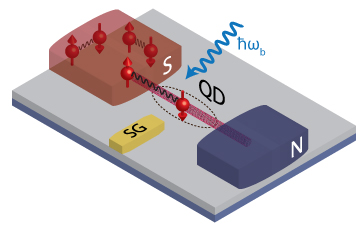Electrons Always Find a (Quantum) Way

Transport process of electrons from a superconductor (S) through a quantum dot (QD) into a metal with normal conductivity (N). Illustration: University of Basel, Department of Physics
Transport properties such as electrical conductivity play an important role in technical applications of new materials and electronic components. Completely new phenomena occur, for example, when you combine a superconductor and nanometer-sized structures, known as quantum dots, in a component.
Researchers at the University of Basel working under Professor Christian Schönenberger have now constructed such a quantum dot between a superconductor and a metal with normal conductivity to study electron transport between the two components.
It should in fact be impossible to transport electrons from the superconductor through a quantum dot at low energies. Firstly, electrons never occur on an individual basis in a superconductor but rather always in two's or in so-called Cooper pairs, which can only be separated by relatively large amounts of energy. Secondly, the quantum dot is so small that only one particle is transported at a time due to the repulsive force between electrons.
In the past, however, scientists have repeatedly observed that a current nonetheless runs between the superconductor and the metal – in other words, electron transport does occur through the quantum dot.
First evidence of the transport mechanism through a quantum dot
On the basis of quantum mechanics, theories were developed in the nineties which indicated that the transport of Cooper pairs through a quantum dot is entirely possible under certain conditions. The prerequisite is that the second electron follows the first very quickly, namely within the time roughly stipulated by Heisenberg's uncertainty principle.
The scientists at the University of Basel have now been able to accurately measure this phenomenon. In their experiments the scientists found the exact same discrete resonances that had been calculated theoretically. In addition, the team including doctoral student Jörg Gramich and his supervisor Dr. Andreas Baumgartner was able to provide evidence that the process also works when energy is emitted into the environment or absorbed from it.
“Our results contribute to a better understanding of the transport properties of superconducting electronic nanostructures, which are of great interest for quantum technology applications”, says Dr. Andreas Baumgartner.
Original source
J. Gramich, A. Baumgartner, and C. Schönenberger
Resonant and inelastic Andreev tunneling observed on a carbon nanotube quantum dot
Physical Review Letters 115, doi: 10.1103/PhysRevLett.115.216801
Further information
Dr. Andreas Baumgartner, University of Basel, Department of Physics, tel. +41 61 267 39 06, email: andreas.baumgartner@unibas.ch
Media Contact
More Information:
http://www.unibas.chAll latest news from the category: Physics and Astronomy
This area deals with the fundamental laws and building blocks of nature and how they interact, the properties and the behavior of matter, and research into space and time and their structures.
innovations-report provides in-depth reports and articles on subjects such as astrophysics, laser technologies, nuclear, quantum, particle and solid-state physics, nanotechnologies, planetary research and findings (Mars, Venus) and developments related to the Hubble Telescope.
Newest articles

A ‘language’ for ML models to predict nanopore properties
A large number of 2D materials like graphene can have nanopores – small holes formed by missing atoms through which foreign substances can pass. The properties of these nanopores dictate many…

Clinically validated, wearable ultrasound patch
… for continuous blood pressure monitoring. A team of researchers at the University of California San Diego has developed a new and improved wearable ultrasound patch for continuous and noninvasive…

A new puzzle piece for string theory research
Dr. Ksenia Fedosova from the Cluster of Excellence Mathematics Münster, along with an international research team, has proven a conjecture in string theory that physicists had proposed regarding certain equations….



